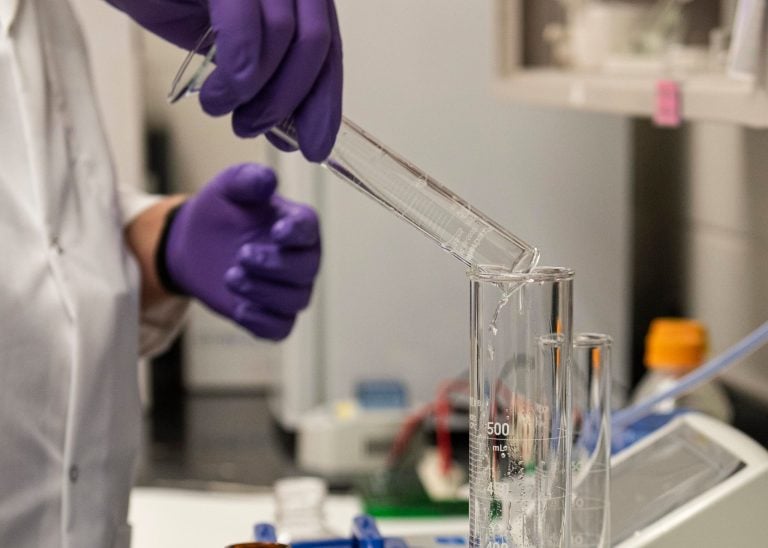Many Stanford research labs have transitioned the focus of their studies to aid in the search for a COVID-19 treatment. Despite the time pressure and the dangers of working with a highly infectious virus, Stanford labs have used their knowledge from past projects to begin their research.
Amidst Santa Clara County’s shelter-in-place order, essential Stanford labs were allowed to remain open if they upheld many safety precautions. Associate professor of infectious diseases Catherine Blish made the switch to COVID-19 research in her lab.
“It wasn’t entirely seamless, when the shelter-in-place came down we still had ongoing tuberculosis experiments where we had to, that day, kill cultures, but at the same time we were already starting to build a COVID-19 programs from when we heard about this in January,” Blish told the Future of Everything podcast.
Professor of medicine, microbiology and immunology Jeffery Glenn has also recently made the switch to conducting COVID-19 research in his lab. At the onset of the pandemic, Glenn started to observe how his lab’s previous advancements in antiviral drug research could be refocused to target the virus.
One of Glenn’s research projects focuses on a class of viruses called enterovirus, a respiratory virus, which, when severe, can cause paralysis in children. Glenn and his team have developed the only molecules that have shown efficacy in trials conducted on animals. The therapy has a 100% survival rate and can reverse the paralysis.
“It turns out that the same thing that our drug targets, and why it’s important for enteroviruses, had already been shown to be important for how the SARS virus gets into cells,” Glenn said. “SARS CoV-2, the causative agent of COVID-19, enter cells in the same mechanism, so it was pretty clear to us that our drugs had the potential to also be useful against COVID-19.”
Glenn’s lab has also developed a molecule to target the influenza virus, which has already been proven to be very successful in mice. Using the knowledge gained from this study, Glenn was able to accelerate his COVID-19 research.
“We leveraged all these years of work, and the lessons learned, and we were able to leapfrog over a lot of more methodical research we did in the past, to very rapidly get to some very compelling therapeutic candidates,” he said.
Typically an influx of influenza cases appears during the fall and winter, otherwise known as the flu season, meaning many people may soon be infected with both the flu and COVID-19. However, the therapeutic Glenn has developed to combat influenza has the potential to be combined with the therapeutic for COVID-19 to help many patients who are co-infected.
When researching and developing therapeutics for highly infectious diseases like COVID-19, there is always a health risk involved. The virus could potentially infect the researcher who is working with it, but fortunately, Glenn is highly accustomed to working with infectious diseases and has very detailed procedures for how to safely handle the pathogens.
Research labs take different safety precautions depending on how dangerous or infectious the pathogen may be. COVID-19 requires the highest level of safety precautions, or respiratory biosafety level three, because it is an airborne pathogen. Researchers must work in an air filtered cabinet, be covered head to toe in plastic, wear multiple pairs of gloves, and wear a respirator.
“We always need to exercise caution, because our research is important, but for people to be safe is more important,” Glenn said. “I think if you do it correctly and well thought out, you can do both.”
Transitioning research towards combating COVID-19 was expensive, however. Normally, processing a research grant would take about a year from the time the grant is submitted to the time the money is received. However, due to the time pressure added by the pandemic, waiting for grant money is not always a possibility.
“There’ve been some very nice foundations that have been helping researchers,” Glenn said. “But that’s just another practical aspect of research, it’s very expensive, and it helps to have highly talented people and to be able to really move something in a meaningful way.”
Stanford is offering many internal funding opportunities for researchers, and has compiled a list of the funding opportunities they are offering, along with funding opportunities from other sources.
Despite the struggles, Glenn has confidence that therapeutics for the virus will be found, and feels fortunate to have the resources to conduct his research.
“It’s a privilege to be in a position to have the training, the resources, the teams, and to have the chance to do something impactful.” Glenn said. “And that’s why we do what we do. So it was a wonderful opportunity and honor to be able to contribute where we can to this effort.”
Contact Paisley Annes at paisleyj101 ‘at’ gmail.com.
